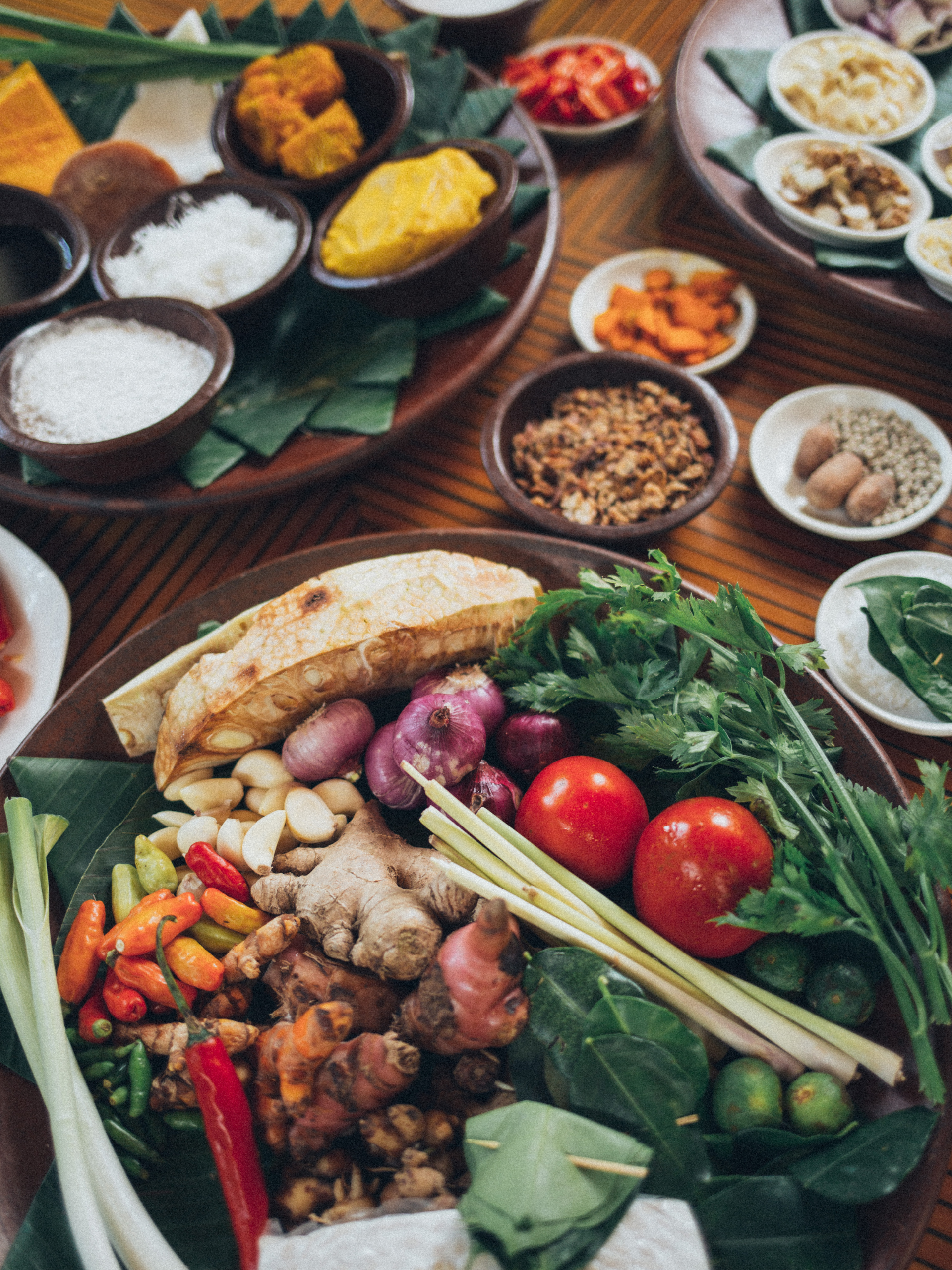

Food is a feminist issue
WHY FOOD & FEMINISM?
Although food has evolved to be many things nowadays, from gathering people together to an innovative industry, the purpose of food is essential to keep people, animals, and plants alive (Cambridge Dictionary, 2020d). Thus food can be directly linked to multiple articles of the Universal Declaration of Human Rights (United Nations, 1948), where life is a right to all humans.
Nonetheless, not everybody has the same access to food, and food is accompanied by many social stigmas. Women face such disadvantages with regards to food, contrary to the belief of feminism, where “women should be allowed the same rights, power, and opportunities as men and be treated in the same way” (Cambridge Dictionary, 2020c). Since 2015 the United Nations (UN) has implemented 17 Sustainable Development Goals (SDGs) to achieve by 2030 (United Nations, 2020b). Amongst them, Zero Hunger (SDG 2), Good Health and Well-Being (SDG 3), and Gender Equality (SDG 5). Goals demonstrating that both food and feminism are universal.
As universal subjects, this essay compiles information on a global scale and at numerous moments in time exploring why food is a feminist issue.
ACCESS TO FOOD & FOOD SECURITY
In 2017, 821 million people were undernourished (OXFAM, 2019), and the number continues to increase by 10 million people every year (United Nations, 2020a). The majority is in Asia, followed by Africa which is also the continent where hunger is growing the fastest in the world (ibid). Starvation and food insecurity are high especially among rural women (OXFAM, 2019).
Gender inequalities lead women to face disadvantages in the agricultural world due to discrimination and limited bargaining power. In many countries women do more than men when it comes to agriculture, whilst “men are seen as masters, so [they only] may actually plow the land” (Manoj, 1997). Within the workspace and at home women have difficulties with regards to food security, which entails its availability, access, utilization, and stability. Thereby, they tend to suffer more than men by having nutrient deficiencies and lower job securities accompanied by lower incomes when, to begin with, “they frequently spend a bigger share of their family budget on food than male heads of household” (OXFAM, 2019).
Furthermore, obtaining insufficient or the wrong nutrients during reproductive years and pregnancy can cause a number of health problems such as malformations, increased miscarriage rates, perinatal mortality, and other long-term effects (SURG, 2008; OXFAM, 2019). Additionally, to tackle the persistence of malnutrition for the next generations, women tend to reduce their own consumption to feed others, collect wild food, migrate or sell assets, and take on risky jobs (OXFAM, 2019). It is also common for women in agriculture to suffer from sexual abuse (BBC: The Food Chain, 2018). As low wage workers, they are “more likely to experience sexual harassment
Due to the disadvantages women face, impacting SDG 3, access to food & food security is a feminist issue. What is more, the World Food Programme and Gallup Inc collaborated to develop the "Gender Equality for Food Security" (GE4FS) measure. Although this measurement is still in development, women’s empowerment (the five core dimensions being: decision-making ability, financial self-sufficiency, freedom from violence, reproductive freedom and unpaid labor) linked to achieving SDG 5 “is a must for a world of Zero Hunger(SDG 2); where all women, men, girls and boys can exercise their human rights, including their right to adequate food” (World Food Programme, 2020).at work” (ibid). In fact, a Mexican study shows that 80% of agriculture workers undergo sexual abuse at work (bid). Additionally, these workers also tend to stay silent for fear of making the situation worse, including losing their jobs (ibid).
DINING ETIQUETTE & THE RESTAURANT INDUSTRY
Dining “rules for correct or polite behaviour” (Cambridge Dictionary, 2020b) differ given ones’ socio-economic situation and culture. Despite these differences, women are still commonly discriminated at mealtimes and in restaurants.
Firstly, in many cultures, women are the last to be served food at social gatherings, and in some cultures, only eat after men have finished and left the table. Yet as mentioned previously, often women do more than men when it comes to cultivating the food, but they are also the ones to prepare, serve and clean up after meals whilst also taking on other house roles like taking care of the children. Eating after and last also has a direct effect on women’s nutritional intake as they are not sure to be left with enough and/or nutritious food (Women’s Web, 2016; Manoj, 1997; Action Against Hunger, 2017; Mochizuki, 2020).
This is contrary to most western cultures like in the United States (US) for instance, whether it be taking an order or being served at a restaurant, ‘ladies first’ is etiquette. It was hard to determine exactly why this is, apart from it being polite to place women before men (Perry, 2018; Etiquette Scholar, 2019; Modern Gentleman, 2019).
Historically dining etiquette are evolving with some restaurants actually teaching their staff not to obey the ‘ladies first’ rules. To treat women and men as equals, and simply not using any gender terms like these do not only refer to the female or male sex (Perry, 2018). Other aspects of eating out have also become less sexist, and more aligned with SDG 5.
Before the 1970s some places did not allow women to enter without men. Some restaurant sections were restricted to women and if open to both would restrict certain areas at lunchtimes for instance because ‘women took too long eating and gossiping’ whilst men had less time and needed faster service to be able to get back to work (Perry, 2018; Voss, 2015; Freedman, 2014).
The ‘Ladies Menu’ is also an element that no longer exists. High-end restaurants used to exclude prices from menus for women as they assumed men would pay, and women should not be bothered by seeing the price of a meal (Perry, 2018; Frost, 2018). Still today, most of the time when dining out, the waiter delivers the check directly to the man, instead of to me, a woman. Other issues exist that make dining a disagreeable experience. Firstly, about the amount and types of food women are expected to eat according to our societies. A few personal examples when dining out with a man include either the waiter or the man assuming I will or have ordered a salad, and on occasion even suggesting I order a salad whilst they order the steak. Secondly, around what happens in the working environment. Most owners, chefs, managers and higher-paying roles in the restaurant industry are men (Johnson and Madera, 2018), and sexual harassment is more common in the restaurant industry than in any other industry (Stewart, 2017; Johnson and Madera, 2018).
Furthermore, the lower-paying jobs are occupied mostly by women (ibid), and as mentioned previously, sexual abuse is more likely to occur under these circumstances (BBC: The Food Chain, 2018). In fact, in the restaurant industry, 90% of women reported experiencing sexual harassment, whether it be by chefs, managers, co-workers, or customers (ibid). Due to the social stigmas, women face during meals, dining etiquette is a feminist issue. And what happens to many workers in these establishments makes the restaurant industry a feminist issue too. Hindering SDG 3 and 5.
DIETING CULTURE & BODY IMAGE
Dieting is not something new, the oldest references to diet come from the Ancient Greeks. Diaita meant a way of living, where a healthy mind and body lead to a healthy society (Gastropod, 2018). The purpose of dieting was then to achieve SDG 3. The Latin diaeta and diaitan describe a dietary regimen as well as was a verb which meant “to lead, govern, or arbitrate one’s life (Culinary Lore, 2014)”. However, nowadays a diet can be defined as “an eating plan in which someone eats less food, or only particular types of food because they want to become thinner or for medical reasons” (Cambridge Dictionary, 2020a). So when was the shift made of a diet becoming an eating plan rather than a way of living in general? Here we explore the disadvantages women face because of the influence of dieting culture on body image.
In this culture, individuals were responsible for representing the rest of society and this was reflected by the way you looked. This healthy lifestyle revolved around food, drink, sleep, and exercise (Foxcroft, 2013). Being overweight manifested mental unbalance, ugliness, poor sleep, “aches, pains, flatulence, and constipation” (Skyterra Wellness, 2020a) which according to Hippocrates needed to be corrected by diet, drugs, exercise and vomiting (Aletra, 2004). But if a man’s body was the ideal health image, what did this mean about women’s body image?
Although statues in the Antiquity show women with large and curvy bodies, there were already signs of a waist-cinching garment worn by women in Crete (Ewing, 1978). Additionally, in China during the Han Dynasty, slim bodies represented feminine beauty (Hinsch, 2006).
After Christ, it was common among Christians to believe that a larger body meant a sinful one of gluttony, one of the seven deadly sins (Foxcroft, 2013). Furthermore, during the Middle Ages, Anorexia Mirabilis appeared, an eating disorder(ED) also known as Holy Anorexia or Fasting Girls (Jacobs Brumberg, 1988). There are numerous examples of individuals who intentionally starved themselves for devotion and to commemorate Christ’s suffering (Forcen, 2013; Muhlheim, 2020). Nonetheless, this was most common among women, as men found other ways to endure physical pain other than fasting (Bynum, 1987). An example is Catherina of Siena during the 14th century. Following her older sister’s ways, who ate less in attempts to change her husband’s poor character, used fasting as a way of revolting and being devoted to Christ (Gardner, 1907). After her sister’s death, her parents wanted her to marry her sister’s former husband. She resisted the arranged marriage by fasting and eventually died of starvation (ibid).
Early Christian thoughts on gluttony were that “women were thought to be weak and corrupt, and particularly susceptible to temptation” (Gastropod, 2018). Is this why statues during the Middle Ages also represented curvy women, because they were sinful, not a sign of beauty?
These included a mix of food plans, drugs, and exercise. Nonetheless, these were intended for men and women. An example is The Art of Living Long by Cornaro published in 1558. The author used his own life experience, where he had over-indulged which made him ill, and wrote a dieting book to get him back to health so he could live. This was the beginning of restrictive eating by counting the amounts of food and which foods to eat. Once he was slim again, he also said he felt more masculine. He thought of excess as being sinful, feminine (ibid). Although body-shaping accessories had been used during other periods as mentioned earlier, it is during the 16th century, when they became the norm for women to wear as an undergarment (Ewing, 1978). Corsets were meant to make women’s waists slimmer, but also restrict too much food consumption (ibid).
At the same period in time during the Qing Dynasty in China, the ‘ideal body’ for women was also a thin one (Wang, 2018).
“In the late 1970s and 1980s fundamentalist Christian groups in America were producing books which promoted rigorous weight loss for women” (Foxcroft, 2013).
Numerous scientific studies show that women need fewer calories than men, with the advised daily calorie intake being 2000 for women and 2500 for men (NHS, 2019). However, this amount has varied over time. In fact, the first calorie counting book, entitled Dieting and Health: With Key to the Calories; published in 1918 by Dr. Lulu Hunt Peters recommended 1200 calories for women per day (Skyterra Wellness, 2020a).
After World War I, conceptions of the ideal body were that “Fat is repulsive. Slim and boyish is sexier than womanly” (Rubenstein, 1918). But dieting was not just about food. All sorts of dieting methods started to appear, such as different drugs, massages, cosmetic products, cigarettes etc. (Skyterra Wellness, 2020b). Media also had a huge role to play by promoting these new methods. It was only in 1943 that the US government started announcing “its first guidelines for good nutrition” (ibid). Suggesting eating from “seven food groups every day: vegetables, citrus and salad greens, potatoes and fruits, milk and dairy, meat and poultry, bread and cereals, and butter and margarine” (ibid).
In the meantime, women’s magazines still published weight-loss diets and exercise routines (ibid). Since then, the preoccupation around losing weight has only increased (Foxcroft, 2013), with dieting culture being more about body image in society, rather than religion, and triggering more EDs. Furthermore, a gender gap has always existed in EDs, being more common among women (George, 1989). And women globally, no matter their age, race or socioeconomic status (The Food Chain, 2018; Food Psych, 2020). In fact, “black teenagers are 50% more likely to exhibit bulimic behavior” (Sovinsky et al., 2011).
However, the fight against dieting culture and body image issues is more evident nowadays than ever. With celebrities such as Lizzo being “the first big black woman on the cover of @voguemagazine” (Lizzo, 2020). But fat acceptance followed by body positivity was part of the first feminist wave in the 19th century (Kriebl, 1998). From the Victorian Dress Reform in England, where it was all about loosening corsets, and women wearing more practical clothes (ibid), to the creation of the National Association to Advance Fat Acceptance in 1969 in the US with Health at Every Size (NAAFA, 2020), up until today with Body Positivity, advocating that all bodies n0 matter which size, gender, race, physical abilities and appearance should be accepted (Cherry, 2020).
Yet history and figures show that dieting culture & body image is still a feminist issue, despite the ongoing combat against the social stigmas (Food Psych, 2015a; Food Psych, 2015b) and the fight towards SDG 3 and 5.
WHAT NOW?
Women have always faced disadvantages when it comes to food. From accessing it & securing it, eating it & working with it, to learning about it & consuming it. It is appalling that despite decades of resistance, all over the world, women still face inequalities regarding food, directly hindering 3 SDGs.
So I want to ask you the following question: Now that you have witnessed why Food is Feminist Issue, will you do anything to change this?
- Jasmine du Pontavice



